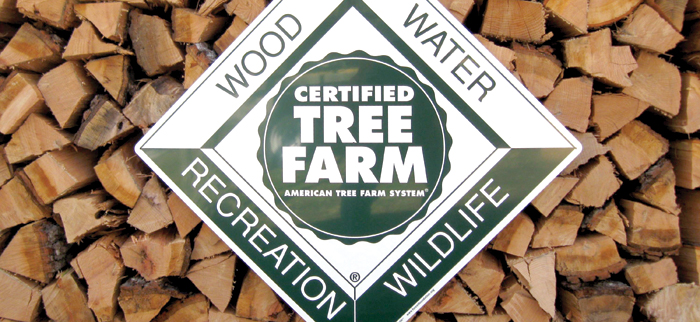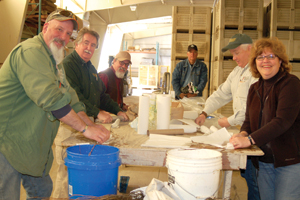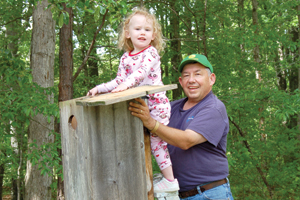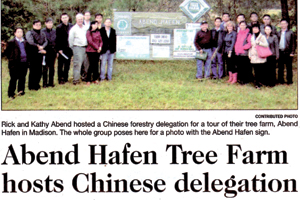The American Tree Farm System: Celebrating 75 years

Department of Natural Resources forester Scott Daniels remembers that day nearly 30 years ago like it was yesterday.
He was on his way to the Dorchester County homestead of Richard Abend, a federal worker who spent his free time tending the 106-wooded acres of Abend Hafen Farm—German for “Evening Heaven.”
As part of his duties, Daniels was helping Abend with a routine update of his forest management plan. Abend—Rick to his friends—was a firm believer in replacing the trees he harvested, a practice that would later become known as sustainable forestry.
But Daniels has another reason for the visit. He hoped to convince Abend to join the American Tree Farm System, a little-known program that embraced the sustainability philosophy.
The forester stepped from his truck, checked his boots for mud and knocked on the front door.
The rest, Daniels says today, is a Maryland forestry success story.

Scott Daniels, Rick and Kathy Abend, and Kathy’s mother, Jean Small
Tree farm history
The American Tree Farm System had been active in Maryland for decades, but despite an active role in local conservation efforts, Abend was unaware of it. The national program started in 1941, and in 1948, Maryland became the 21st state to join.
Governor William Preston Lane dedicated the first tree farm—a property owned by the Pennsylvania-based Glatfelter Pulpwood Company—at a ceremony held at the historic Old Durham Church in Charles County. All involved hoped that Maryland’s income from forest products would double, and forests would be better protected from fires.
The program slowly grew throughout the 1950s and 1960s, and forest landowners took notice. H.C. Buckingham and J.C. McClellan—state forester and the chief forester of what is now the American Forest Institute—presided over the first state committee at the Lord Baltimore Hotel in December 1956. McClellan emphasized they were not seeking “window dressing tree farms but concrete examples of on-the-ground forestry.” He further stated that, “A tree farm…should always be a woodland to which you could take anyone and say, ‘This is good forestry.’”
An evolving system
| In 2016, the American Tree Farm System will celebrate its 75th anniversary with more than 80,000 tree farmers and 20 million acres of forest active in the program. |
Over time, the committee makeup shifted from industry representatives to private landowners. Four representatives now serve on the Maryland Tree Farm Committee, with others serving in officer roles.
Today, Maryland remains one of 44 states with an active tree farm presence and a functioning committee, which still seeks membership from landowners with exemplary forest management. With 800 tree farms across the state and more than 1,000 owners, the program represents over 5 percent of all Maryland forests.

Wrapping seedlings for Arbor Day
Current events
Active across the state, the Maryland Tree Farm Committee hosts many events. It sponsors tours for landowners who want to see a working tree farm, often with dozens of people in attendance. It names a State Tree Farmer of the Year, as well as a Tree Farm Inspector of the Year. The most popular event, by far, appropriately occurs on Arbor Day, when members hand out seedlings to legislators at the State House, who also take a moment to recognize the award recipients. Rick and his wife Kathy attended in 2015.

Rick and his granddaughter check a wood box
A successful sell
As it turns out, “We were the perfect candidates for the American Tree Farm System,” recounts Rick. “Since [Scott enrolled us in the program], we have been involved in two thinning projects, and two major timber harvest and reforestation projects, along with many timber stand improvement efforts—all done with wildlife management in mind.”
Still the forester for Dorchester County, Daniels has been there every step of the way to help with federal and state cost-share applications to help get the work done. He also updates their forest management plan periodically to adhere to the system’s Standards of Sustainability, which are updated every five years.
The standards provide great guidance and clarity about what is expected. They ensure that tree planting, or regeneration, occurs after every harvest, that fire and chemicals are used appropriately and responsibly, that laws are followed, that rare species are protected and more.
An added benefit of enrolling in the tree farm program, certification can add to the value of timber sold from the property, while making other landowners consider ecological, cultural and historic values of the land.
Currently, the American Tree Farm System is the only certification option for small, non-industrial forest landowners, like Abend Hafen Farm.

Newspaper clipping
Expanding the experience
The Abend’s farm exemplifies what sustainable forestry can look like in Maryland. For their efforts, they were named Maryland Outstanding Tree Farmers of the Year in 2014.
Abend liked the tree farm program so much he began serving as the committee’s eastern region representative.
The Abend’s also graciously open their tree farm for hundreds of visitors each year, including kids, foresters, politicians and other conservation-minded individuals and groups.
This recently included a delegation of 16 Chinese forestry professionals wanting to learn about sustainable management. How do you say, “This is good forestry” in Mandarin?
Article by Rob Feldt—forester, geographic information system planner and Maryland Tree Farm Committee Database Chair. Photos courtesy of Rick Abend.
Appears in Vol. 19, No. 2 of the Maryland Natural Resource magazine, spring 2016


 1-888-373-7888
1-888-373-7888 233733
233733